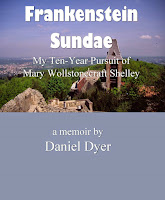 Lodore remains in print (as do Mary’s
other books—though some are print-on-demand), and my copy, which I bought and read very early in my research (May 1997, only about six months after I retired from public-school teaching and began spending most of my time reading about Mary and her circle). Edited by Lisa Vargo (and published by Broadview, 1997),
the volume features a photograph from ca. 1855 (an unknown photographer)
showing a formally dressed man (complete with an Abe-Lincoln top hat) sitting
on Table Rock, which has, due to various collapses, considerably diminished
from its once expansive dimensions. In 1850, a huge chunk fell. At the time a
man and his carriage were on it; he escaped; the carriage didn’t.
Lodore remains in print (as do Mary’s
other books—though some are print-on-demand), and my copy, which I bought and read very early in my research (May 1997, only about six months after I retired from public-school teaching and began spending most of my time reading about Mary and her circle). Edited by Lisa Vargo (and published by Broadview, 1997),
the volume features a photograph from ca. 1855 (an unknown photographer)
showing a formally dressed man (complete with an Abe-Lincoln top hat) sitting
on Table Rock, which has, due to various collapses, considerably diminished
from its once expansive dimensions. In 1850, a huge chunk fell. At the time a
man and his carriage were on it; he escaped; the carriage didn’t.
Lodore has a scene at Niagara Falls—and we’ll
get to that in a bit—and to the various ways that Niagara Falls figured in the
lives of some people she knew well, especially Edward John Trelawny, the bold
braggadocio who had helped with the cremation of her husband in 1822 and whose
life and writing intertwined with Mary’s until her death in 1851—and even
beyond.
Lodore—as was the custom at the time—appeared
in three volumes. There was a reason for these many multi-volume publications. The
private lending libraries—popular and pervasive at the time—could satisfy more
customers by checking out the volumes in sequence so that one reader, say, didn’t
hog the entire book for weeks on end.
Volume I begins,
writes Mary, in the flattest and least
agreeable part of the county of Essex, about five miles from the sea ….[1] A
small village. A mansion, rarely inhabited by the Fitzhenry family. Henry
Fitzhenry—also called Lord Lodore—married a beautiful and mysterious woman—An angel bright with celestial hues,
breathing heaven, and spreading a halo of calm and light around ….[2]
Mary, Mary …
a bit excessive, eh? Florid?
Anyway, Lord
Lodore’s young wife—who seems to have stepped from the pages of a contemporary
romance novel—has died. And Lodore disappears, leaving only his sister,
Elizabeth, behind in the house. Years have passed, and he is now fifty years
old.
Mary, I’m
sure, used the number fifty as a way to communicate age—being old—but I,
seventy-two as I write these words, can think only of the youth of fifty years!


No comments:
Post a Comment